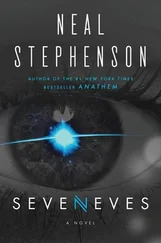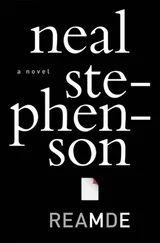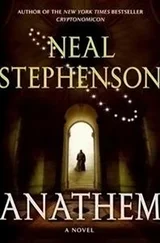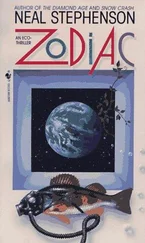“Jesus Christ!” Comstock says. He remembers the trucks now, their incessant comings and goings, fender-benders in the motor pool, exhaust fumes coming through his window, the enlisted men shoving heavy carts up and down the hallways, laden with boxes. Running over people's feet. Scaring the secretaries.
And the noise. The noise, the noise, from Waterhouse's goddamned machine. Flowerpots vibrating their way off file cabinets, standing waves in coffee cups.
“Wait a sec,” says one of the ETC men, with the nasal skepticism of a man who has just realized he's being bullshitted. “I saw those trucks. I saw those cards. Are you trying to get us to believe that you were actually running a statistical analysis on each and every single one of those message decrypts?”
Waterhouse looks a little defensive. “Well, that was the only way to do it!”
Comstock's math whiz is homing in for the kill now. “I agree that the only way to accomplish the analysis that is implied by that”—he waves at the mandala of intersecting polygons on Waterhouse's map—“is to go through all of those truckloads of old decrypts one by one. That is clear. That is not what we are objecting to.”
“What are you objecting to, then?”
The whiz laughs angrily. “I'm just worried about the inconvenient fact that there is no machine in the whole world that is capable of processing all of that data, that fast.”
“Didn't you hear the noise?” Waterhouse asks.
“We all heard the goddamn noise,” Comstock says. “What does that have to do with anything?”
“Oh,” Waterhouse says, and rolls his eyes at his own stupidity. “That's right. Sorry. Maybe I should have explained that part first.”
“What part?” Comstock asks.
“Dr. Turing, of Cambridge University, has pointed out that bobbadah bobbadah hoe daddy yanga langa furjeezama bing jingle oh yeah,” Waterhouse says, or words to that effect. He pauses for breath, and turns fatefully towards the blackboard. “Do you mind if I erase this?” A private lunges forward with an eraser. Comstock sinks into a chair and grips its arms. A stenographer reaches for a benzedrine tablet. An ETC man chomps down on a number two lead pencil like a dog on a drumstick. Strobes flash. Waterhouse grabs a fresh stick of chalk, reaches up, and presses its tip to the immaculate slate. The crisp edge of the stick fractures with a slight pop, and a tiny spray of chalk particles drifts to the floor spreading into a narrow parabolic cloud. Waterhouse bows his head for a minute, like a priest getting ready to stride up the aisle, and then draws a deep breath.
The benzedrine wears off five hours later and Comstock finds himself sprawled across a table in a room filled with haggard, exhausted men. Waterhouse and the privates are pasty with chalk dust, giving them a ghoulish appearance. The stenographers are surrounded with used pads, and frequently stop writing to flap their limp hands in the air like white flags. The wire recorders are spinning uselessly, one reel full and one empty. Only the photographer is still going strong, hitting that strobe every time Waterhouse manages to fill the chalkboard.
Everything smells like underarm sweat. Comstock realizes that Waterhouse is looking at him expectantly. “See?” Waterhouse asks.
Comstock sits up and glances furtively at his own legal pad, where he hoped to draw up an agenda. He sees Waterhouse's four assertions, which he copied down during the first five minutes of the meeting, and then nothing except a tangled field of spiky doodles surrounding the words BURY and DISINTER.
It behooves Comstock to say something. “This thing, the, uh, the burying procedure, that's the, uh—”
“The key feature!” Waterhouse says brightly. “See, these ETC card machines are great for input and output. We've got that covered. The logic elements are straightforward enough. What was needed was a way to give the machine memory, so that it could, to use Turing's terminology, bury data quickly, and just as quickly disinter it. So I made one of those. It is an electrical device, but its underlying principles would be familiar to any organ maker.”
“Could I, uh, see it?” Comstock asks.
“Sure! It's down in my lab.”
Going to see it is more complicated. First everyone has to use the toilet, then the cameras and strobes have to be moved down to the lab and set up. When they've all filed in, Waterhouse is standing next to a giant rack of pipes with thousands of wires hanging out of it.
“That's it?” Comstock says, when the group is finally assembled. Pea-sized drops of mercury are scattered around the floor like ball bearings. The flat soles of Comstock's shoes explode them into bursts rolling in all directions.
“That's it.”
“What did you call it again?”
“The RAM,” Waterhouse says. “Random Access Memory. I was going to put a picture of a ram on it. Y'know, one of those sheeps with the big huge curly horns?”
“Yes.”
“But I didn't have time, and I'm not that good at drawing pictures.” Each pipe is four inches in diameter and thirty-two feet long. There must be a hundred of them, at least—Comstock is trying to remember that requisition that he signed, months ago—Waterhouse had ordered enough drain pipe to plumb a whole goddamn military base.
The pipes are laid out horizontally, like a rank of organ pipes that has been knocked flat. Stuck into one end of each pipe is a little paper speaker ripped from an old radio.
“The speaker plays a signal—a note—that resonates in the pipe, and creates a standing wave,” Waterhouse says. “That means that in some parts of the pipe, the air pressure is low, and in other parts it is high.” He is backing down the length of one of the pipes, making chopping motions with his hand. “These U-tubes are full of mercury.” He points to one of several U-shaped glass tubes that are plumbed into the bottom of the long pipe.
“I can see that very plainly, Waterhouse,” Comstock says. “Could you keep backing up to the next one?” he requests, peering over the photographers' shoulder through the viewfinder. “You're blocking my view—that's better—farther—farther—” because he can still see Waterhouse's shadow. “That's good. Hit it!”
The photographer pulls the trigger, the strobe flares.
“If the air pressure in the organ pipe is high, it pushes the mercury down a little bit. If it's low, it sucks the mercury up. I put an electrical contact into each U-tube—just a couple of wires separated by an air gap. If those wires are high and dry (like because high air pressure in the organ pipe is shoving the mercury down away from them), no current flows. But if they are immersed in the mercury (because low air pressure in the organ pipe is sucking the mercury up to cover them), then current flows between them, because mercury conducts electricity! So the U-tubes produce a set of binary digits that is like a picture of the standing wave—a graph of the harmonics that make up the musical note that is being played on the speaker. We feed that vector back to the oscillator circuit that is driving the speaker, so that the vector of bits keeps refreshing itself forever, unless the machine decides to write a new pattern of bits into it.”
“Oh, so the ETC machinery actually can control this thing?” Comstock asks.
Again with the laugh. “That's the whole point! This is where the logic boards bury and disinter the data!” Waterhouse says. “I'll show you!” And before Comstock can order him not to, Waterhouse has nodded to a corporal standing at the other end of the room, wearing the protective earmuffs that are generally issued to the men who fire the very largest artillery. That corporal nods and hits a switch. Waterhouse slams his hands over his ears and grins, showing a little too much gum for Comstock's taste, and then time stops, or something, as all of those pipes come alive playing variations on the same low C.
Читать дальше





